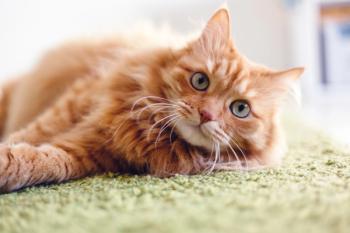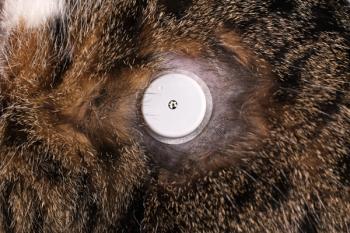
- dvm360 November 2019
- Volume 50
- Issue 11
Its complicated: Foiling the frustrations of diabetes management in pets
Diagnosing diabetes in your veterinary patients may be straightforward, but treating the condition is sometimes anything but. Heres the lowdown on why treatments fail, how best to monitor these patients and what new insulin products are on the market.
Diabetes cases have you (and your clients) howling in frustration? Use these tips to achieve glycemic control.
“Why is my pet's insulin dose so high?” “Should I switch insulins?”
These are the questions that Daniel K. Langlois, DVM, DACVIM, assistant professor of internal medicine at Michigan State University College of Veterinary Medicine, is asked most commonly by pet owners who are frustrated by unremitting clinical signs in their diabetic pets despite the administration of high amounts of insulin.
For the most part, Dr. Langlois told
“But many dogs and cats have poor glycemic control despite being on relatively high doses of insulin, and treatment and monitoring of these patients can be challenging,” he says. Here Dr. Langlois focuses on managing the more frustrating cases of diabetes.
Why does treatment fail?
In many cases, a stepwise approach to treatment can help you avoid the need for referrals and consults, Dr. Langlois says. “But before we go on a big diagnostic hunt, let's make sure there are no insulin handling or administration issues at play,” he says-these account for about 5% to 10% of so-called treatment failures. Rolling instead of shaking the insulin bottle, administering insulin incorrectly (e.g. through the skin) and keeping insulin for too long are among the most common culprits.
“Handling and administration faux pas aren't the most common reasons for poor glycemic control,” Dr. Langlois says, “but if these issues are not identified on the front end, you won't be able to help the client and patient no matter what you do.”
When these issues are not at play, he continues, odds are the problem is insulin resistance. Other potential problems include an inadequate duration of action of insulin, incorrect insulin dosing and an inconsistent routine.
Insulin resistance. Insulin resistance should be suspected when individual insulin doses exceed about 1.5 U/kg in dogs and 0.5 U/kg in cats. “When animals are not responding to these doses, we usually start thinking about insulin resistance,” Dr. Langlois says. This typically means an abundance of counter-regulatory hormones (e.g. cortisol, sex hormones, growth hormone, glucagon, epinephrine, norepinephrine) that are interfering with insulin release, binding or metabolism.
Inflammation and concurrent disease processes commonly result in insulin antagonism, and one of the first steps in assessing the poorly controlled diabetic is to rule in or out such conditions as urinary tract infections, pyoderma and pancreatitis.
Additionally, he noted, glucocorticoids are commonly implicated in cases of poor diabetes control. This includes pets receiving exogenous glucocorticoids as well as those with naturally occurring Cushing's disease. “While we do not test every poorly controlled diabetic for Cushing's,” he says, “we do recommend testing patients with consistent clinical signs.”
Although less common, excess growth hormone due to acromegaly or excess progesterone in intact bitches can also be a factor. If initial physical and laboratory examinations do not identify reasons for insulin resistance, perform abdominal ultrasound and thoracic radiographs to aid in the identification of concurrent disease processes.
This doesn't necessarily mean the pet has Cushing's or acromegaly, Dr. Langlois notes. Many diseases that cause inflammation and stress result in increased secretion of all these hormones, so almost any concurrent disease in an animal has the potential to result in insulin resistance. “If it's not an insulin handling or administration issue, we usually go straight to obesity and diet,” he says. We know that fat does a lot of good things, but excess or hypertrophied fat releases a variety of cytokines and chemokines that all promote a pro-inflammatory state, which leads to insulin resistance.
Fat cats are about four times as likely to develop diabetes as lean cats, Dr. Langlois said. For every kilogram increase in body weight, cats have about a 30% loss in insulin sensitivity. “We also know that overweight dog and cats will have higher postprandial glucose and triglyceride concentrations than lean animals do,” he says. “So, all of these are things we need to address early on and are common reasons for treatment fails.”
Weight loss: the slow and steady approach
Weight loss in diabetic cats is important, Dr. Langlois says, and there are many ways to approach it. Targeting a loss of about 1% of body weight every one to two weeks is appropriate for both dogs and cats. “Addressing the issue incrementally helps to avoid pet behavior issues and owner frustration,” he says.
“We also make sure we're feeding an appropriate diet,” he says. “Cats are obligate carnivores and don't process simple sugars very well, so we try to restrict them from a carbohydrate standpoint.”
Inadequate insulin duration of action. Although not as common as insulin resistance, there are instances when a switch to a different insulin is necessary. Assessing duration of action requires blood glucose curves or use of continuous glucose monitoring as described below.
Importantly, Dr. Langlois says, he never recommends changes in insulin type based off just one or two blood glucose curves. His experience, as well as that of others, suggests that there is substantial day-to-day variability in blood glucose curves in some pets. So it's best to assess multiple data points with consistently documented inadequate duration of action before recommending a switch to a different type of insulin.
“In dogs receiving NPH insulin, we typically switch to Vetsulin, and in dogs receiving Vetsulin, we recommend a switch to ProZinc if financially feasible for the owners,” Dr. Langlois says. “In cats, we will typically recommend switching from glargine to ProZinc or vice versa. If this is not successful, we are now considering the use of a new, more concentrated formulation of glargine.” (More on this to come.)
Inappropriate insulin dosing. A relatively simple problem is when the pet needs more insulin. “Many of the poorly controlled diabetics evaluated at our hospital will be discharged on a higher dose of insulin than what they were previously receiving,” Dr. Langlois says. In some cases, the reliance on spot blood glucose testing or urine dipstick monitoring alone leads to inappropriately low doses. In other cases, the animals may indeed have insulin resistance, but it's not always a fixable problem (i.e. a dog or cat receiving glucocorticoids for management of a life-threatening condition or a cat with concurrent acromegaly). In these cases, he says, more insulin-even at what are typically thought of as high doses-is needed and appropriate for adequate clinical control.
Inconsistent routine. Consistency is key in managing diabetes. Day-to-day changes in diet, treats and activity level will alter daily insulin requirements. “Given that we attempt to maintain dogs and cats on a steady daily insulin dose, these types of changes will decrease glycemic control,” Dr. Langlois says. Lifestyle and quality of life issues may preclude absolute day-to-day consistency, but a major point of emphasis with pet owners is maintaining a relatively consistent schedule for their pets. The timing of feeding, type of food and amount fed should be as consistent as possible. The same holds true for snacks and exercise.
Monitoring musts
Enhanced monitoring is often required to identify the underlying reasons for poor diabetic control. One of the newest tools gaining traction in veterinary medicine is continuous interstitial glucose monitoring using the FreeStyle Libre systems. These systems rely on a small sensor that continuously measures subcutaneous interstitial (not blood) glucose concentrations. Measurements are obtained by a small transmitter/scanning device every minute the device is in place. These measurements can be obtained in real time and, equally as valuable, 10 to 14 days' worth of data can be uploaded, thus allowing detailed retrospective reports and analyses. Studies suggest that this method has good correlation with reference laboratory measurements of blood glucose, and it is likely more accurate than portable blood glucose monitors.
The Freestyle Libre can be used in several ways, Dr. Langlois says, noting that his method is to place the device on the dorsum immediately caudal to the shoulder blades (he recommends watching this video, which describes the technique he uses). “Our initial experience with these devices has been quite encouraging,” he says, noting that most dogs are able to maintain the device for more than 10 days. His team has started using this system to manage pets with diabetic ketoacidosis to avoid the need for repeated venous sampling. “Overall, we have found the data obtained from these systems to greatly improve our management of the poorly controlled diabetic dog,” he says.
Newer insulin options
Insulins available for veterinary use are frequently changing. Dr. Langlois treats the majority of diabetic dogs in his practice with either NPH (neutral protamine Hagedorn) or Vetsulin (porcine insulin zinc suspension, Merck Animal Health); most diabetic cats are treated with Lantus (insulin glargine; Sanofi-Aventis) or ProZinc (protamine zinc; Boehringer Ingelheim). A change in insulin type is not necessary for most animals, he says, but there are certain cases in which a different insulin could be more effective. Two newer options include ProZinc for dogs and Toujeo (glargine U-300; Sanofi-Aventis) for cats.
As a 300-U/ml suspension, Toujeo is a super-concentrated form of glargine that generates a greater tissue reaction that results in even slower absorption. “Because of that tissue reaction, some of the glargine being given is going to be degraded before reaching the systemic circulation,” Dr. Langlois says. He also notes that Toujeo's duration of action and time to peak activity are longer than with detemir, so this also leads to having to give a larger amount-but you should have a smoother glucose curve. As such, Toujeo may be helpful for difficult to control cats in which you're struggling to get optimal control.
“Several clinical trials of Toujeo are currently in process at other institutions, and we have received anecdotal reports suggesting that several refractory diabetic cats have been successfully managed with this insulin,” he says.
In closing, Dr. Langlois notes that changing insulin types is not the solution for most refractory cases, but it is in some. “When we're making decisions it's critical to recognize the day-to-day variability we see,” he says. “You also must be aware of the variability between patients. Different animals will respond to different insulins quite differently.”
References
- Clark M, Thomaseth K, Heit M, Hoenig M. Pharmacokinetics and pharmacodynamics of protamine zinc recombinant human insulin in healthy dogs. J Vet Pharmacol Ther 2012;35(4):342-350.
Articles in this issue
about 6 years ago
Slow down, Billy!about 6 years ago
Predictive diagnostic RenalTech now availableabout 6 years ago
The ABCs of veterinary dentistry: T is for treatmentabout 6 years ago
Zoetis to veterinary students: We want to give you $2,000about 6 years ago
Hills goes small: nutrition center expansion to focus on petite pupsNewsletter
From exam room tips to practice management insights, get trusted veterinary news delivered straight to your inbox—subscribe to dvm360.




